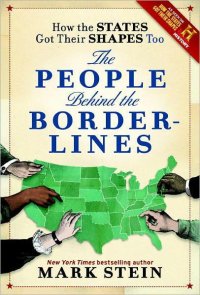
Ebook: How the States Got Their Shapes Too: The People Behind the Borderlines
Author: Mark Stein
- Year: 2011
- Publisher: Smithsonian Books
- Language: English
- mobi
Review
Booklist
Stein’s How the States Got Their Shapes (2008) described why the American states look the way they do—how their borders landed where they did. This equally informative follow-up puts the spotlight on the people responsible for shaping those borders. People like Roger Williams, the Puritan minister who was expelled from the Massachusetts Bay Colony for advocating against the Church of England and established the township of Providence at the tip of the bay, and Anne Hutchinson, also banished, who secured the rights to a small island called Aquidneck by the Indians and Rhode Island by the British. Or—and this is a curious one—Robert Jenkins, the sea captain whose severed ear played a key role in establishing the boundary between Florida and Georgia. Stein, a playwright and screenwriter, writes history the way it should be written, as an entertaining story and not merely a tedious list of names, dates, and places. This is a very interesting follow-up to the earlier book, but it works equally well as a stand-alone.
— David Pitt
KIRKUS REVIEWS
A fun sequel offers more recondite tidbits of American history.
With 50 states, there are plenty of details about border controversies for this mildly titillating follow-up to screenwriter Stein’s How the States Got Their Shapes (2008), which in turn inspired the History Channel’s eponymous documentary. The personalities behind the disputes take center stage: Charles Mason and Jeremiah Dixon, who were actually a pair of highly accomplished English surveyors of the Royal Society possibly hired by Benjamin Franklin to establish impartially the disputed 300-mile Pennsylvania-Maryland-Delaware boundary. “Asking Mason and Dixon to survey a boundary in America,” writes the author, “was... akin to asking Mozart to play at a prom.” Thanks to Ethan Allen (“not a furniture ma...
Product Description
Was Roger Williams too pure for the Puritans, and what does that have to do with Rhode Island? Why did Augustine Herman take ten years to complete the map that established Delaware? How did Rocky Mountain rogues help create the state of Colorado? All this and more is explained in Mark Stein's new book.
How the States Got Their Shapes Too follows How the States Got Their Shapes looks at American history through the lens of its borders, but, while How The States Got Their Shapes told us why, this book tells us who. This personal element in the boundary stories reveals how we today are like those who came before us, and how we differ, and most significantly: how their collective stories reveal not only an historical arc but, as importantly, the often overlooked human dimension in that arc that leads to the nation we are today.
The people featured in How the States Got Their Shapes Too lived from the colonial era right up to the present. They include African Americans, Native Americans, Hispanics, women, and of course, white men. Some are famous, such as Thomas Jefferson, John Quincy Adams, and Daniel Webster. Some are not, such as Bernard Berry, Clarina Nichols, and Robert Steele. And some are names many of us know but don't really know exactly what they did, such as Ethan Allen (who never made furniture, though he burned a good deal of it).
In addition, How the States Got Their Shapes Too tells of individuals involved in the Almost States of America, places we sought to include but ultimately did not: Canada, the rest of Mexico (we did get half), Cuba, and, still an issue, Puerto Rico.
Each chapter is largely driven by voices from the time, in the form of excerpts from congressional debates, newspapers, magazines, personal letters, and diaries.
Told in Mark Stein's humorous voice, How the States Got Their Shapes Too is a historical journey unlike any other you've taken. The strangers you meet here had more on their minds than simple state lines, and this book makes for a great new way of seeing and understanding the United States.
From the Hardcover edition.